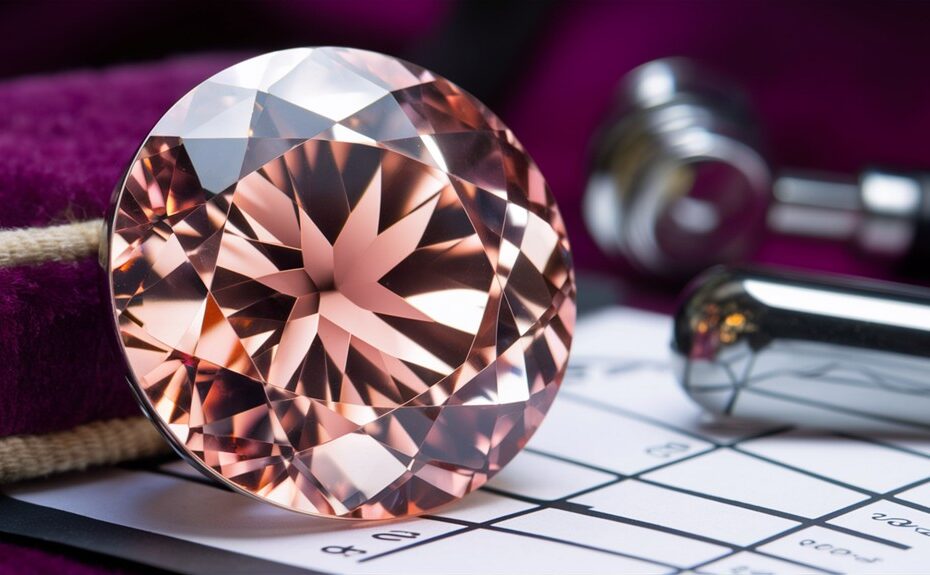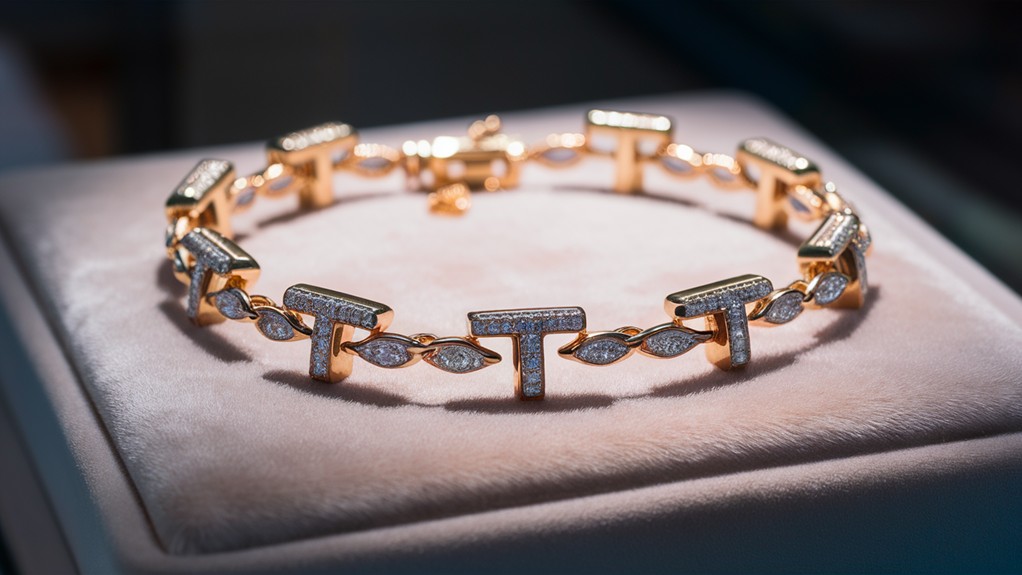If you're considering a morganite gemstone, you'll want to understand its true value. A 12-carat pink beryl can be a stunning addition to your collection, but its price can vary greatly. You'll find that factors like color intensity, clarity, and cut quality play essential roles in determining the stone's worth. While morganite offers a more affordable alternative to diamonds, it's not just about the price tag. There's much more to uncover about this enchanting gem, including its investment potential and how it compares to other precious stones in the market.
Our Highlighted Points
- A 12-carat morganite stone typically ranges from $1,200 to over $3,000, depending on quality factors.
- Deeper pink hues, fewer inclusions, and well-proportioned cuts significantly increase a morganite's value.
- High-quality 12-carat morganites generally fall between $1,200 and $2,700 based on color, clarity, and cut.
- Wholesale prices for morganite range from $85 to $450 per carat, with fine specimens averaging $100 to $225 per carat.
- Gemological certification can enhance a morganite's value by verifying its quality and authenticity.
Morganite Market Overview
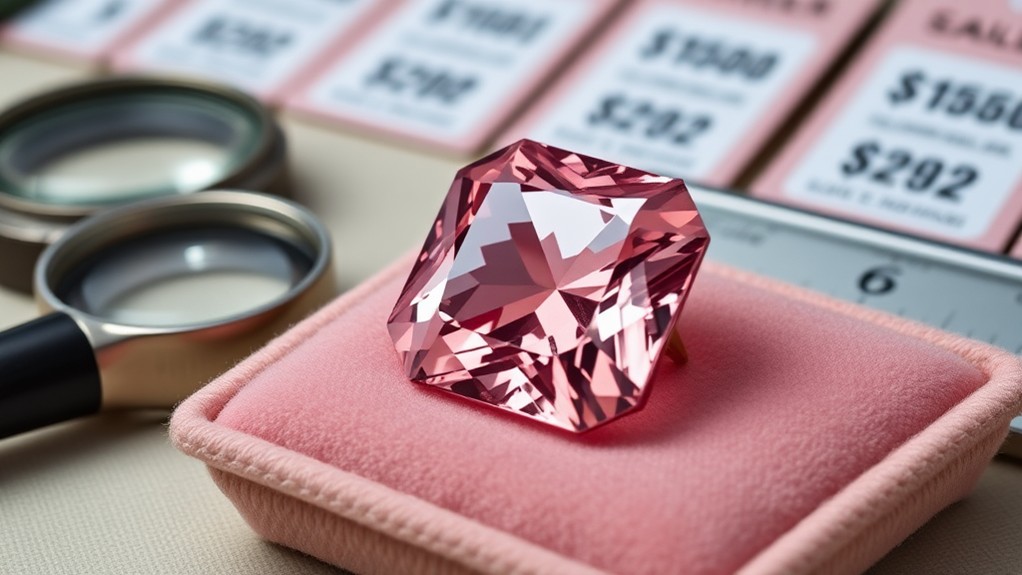
Three key factors drive the morganite market: wholesale pricing, quality determinants, and global sourcing. Understanding these elements is essential for anyone looking to invest in or purchase this sought-after gemstone.
Wholesale pricing for morganite typically ranges from $85 to $450 per carat, with most high-quality stones selling between $100 and $225 per carat. This price range reflects the gemstone's growing popularity and relative affordability compared to diamonds.
For context, fine morganite averages around $300 per carat, while fine white diamonds can cost up to $7,000 per carat.
The value of morganite is greatly influenced by:
- Color: Deeper hues command higher prices
- Clarity: Clearer stones are more valuable
- Cut: Well-proportioned cuts improve brilliance and value
- Carat weight: Larger stones generally fetch higher prices per carat
Global sourcing plays an important role in the morganite market. Primary sources include:
- Madagascar
- Mozambique
- Nigeria (generally more expensive because of quality and rarity)
As morganite's popularity continues to rise, market trends suggest that its value will likely increase, particularly for high-quality specimens with vibrant colors.
This makes morganite an attractive option for both collectors and jewelry enthusiasts seeking a beautiful, yet affordable gemstone.
Factors Affecting 12 Carat Value
While understanding the broader morganite market is important, let's focus on the specific factors that influence the value of a 12-carat morganite stone. The primary determinants of a 12-carat morganite's value are color saturation, clarity, and cut quality.
Deeper pink hues command higher prices, while paler shades are less valuable. Clarity is essential, with fewer inclusions leading to premium price levels for flawless specimens.
The cut quality greatly impacts both aesthetics and value, as well-proportioned cuts improve brilliance and light reflection. Market trends indicate that 12-carat morganite stones can range from $1,200 to over $3,000, depending on these factors.
Furthermore, gemological certification from reputable institutions can raise a stone's value by verifying its quality and authenticity.
When evaluating a 12-carat morganite, consider the following:
- Color intensity: Assess the depth of pink saturation
- Clarity grade: Examine the stone for visible inclusions
- Cut proportions: Evaluate how light interacts with the surfaces
Understanding these factors will help you make an informed decision when purchasing or valuing a 12-carat morganite stone, ensuring you're aware of its true worth in the current market.
Color and Quality Assessment
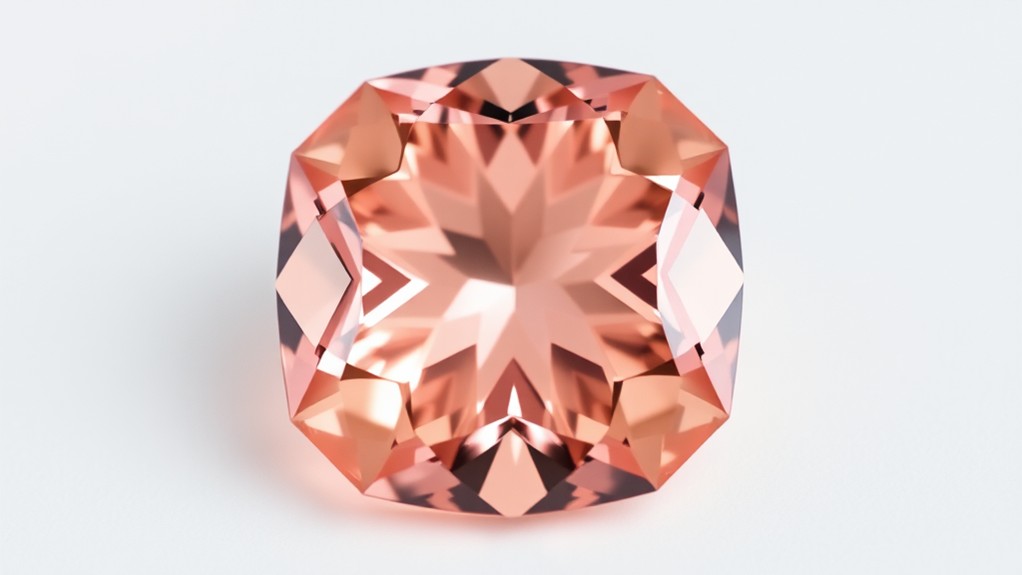
When assessing a 12-carat morganite's color and quality, you'll need to plunge deep into its visual characteristics.
Begin by examining the stone's color saturation, as this is essential for determining its value. A more vibrant pink hue in your pink beryl will command a higher price, potentially reaching several thousand dollars for exceptional specimens.
Next, evaluate the clarity of the morganite. Look for any visible inclusions that could detract from the stone's general appeal. The closer to flawless, the more valuable your 12-carat gem will be. Remember, even minor imperfections can greatly impact the price.
Consider the cut of the stone, as well-proportioned cuts improve brilliance and light reflection. A superior cut can raise the morganite's appearance and, as a result, its value.
To assess total quality:
- Color: Aim for deep, even pink tones
- Clarity: Seek gems with minimal inclusions
- Cut: Look for symmetry and proper proportions
Keep in mind that high-quality 12-carat morganites typically range from $1,200 to $2,700, based on these factors.
Your stone's final value will depend on how well it meets these quality criteria.
Comparing Morganite to Diamonds
As you investigate the world of gemstones, you'll find that morganite offers a compelling alternative to diamonds. This pink beryl variant provides unique aesthetic appeal and ethical sourcing at a fraction of the cost.
While diamonds average around $7,000 per carat, excellent quality morganite typically ranges from $100 to $225 per carat, making it a more accessible option for engagement rings.
When comparing morganite to diamonds, consider these key factors:
- Hardness: Morganite rates 7.5 to 8 on the Mohs scale, while diamonds top the chart at 10, offering superior scratch resistance and brilliance.
- Color: Morganite's soft pink to peach hues provide a distinctive look, whereas diamonds are primarily valued for clarity, cut, and carat weight.
- Ethical considerations: Morganite is sourced from conflict-free locations like Madagascar and Mozambique, making it an ethical choice for conscientious buyers.
While diamonds remain the traditional choice for engagement rings, morganite's value proposition is undeniable. Its lower price point, coupled with its unique color and ethical sourcing, makes it an attractive option for those seeking a distinctive gemstone with emotional significance.
When selecting between morganite and diamonds, weigh these factors carefully to determine which best aligns with your preferences and budget.
Investment Potential of Morganite
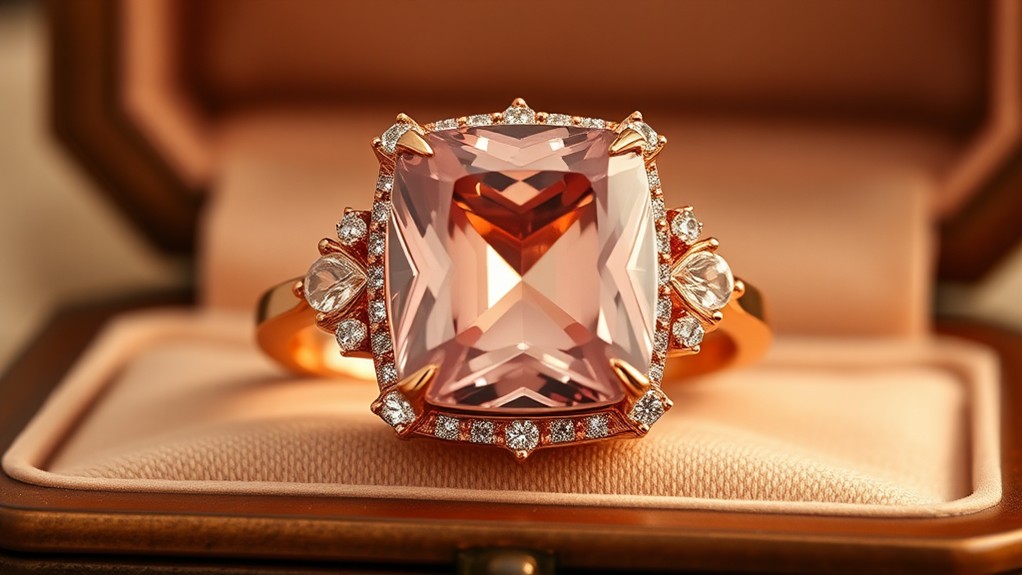
Morganite's investment potential has been gaining traction in recent years. As a gemstone investor, you'll find that morganite offers several attractive qualities. With wholesale prices ranging from $85 to $450 per carat, and high-quality stones fetching between $100 and $225 per carat, morganite presents a compelling opportunity for portfolio diversification.
Consider the following factors when evaluating morganite's investment potential:
| Factor | Impact | Consideration |
|---|---|---|
| Color | High | Deeper hues command higher prices |
| Rarity | Increasing | High-quality, saturated pink stones becoming scarce |
| Ethics | Positive | Conflict-free sourcing |
| Market Appeal | Growing | Rising popularity among consumers |
| Carat Weight | Variable | Larger stones may offer better value |
The gemstone's value is greatly influenced by its color, with saturated pink hues being the most desirable. As high-quality morganite becomes increasingly rare, its investment potential grows. Furthermore, morganite's conflict-free status makes it an ethically sound choice for conscientious investors.
While not a traditional birthstone, morganite's unique characteristics and growing market appeal position it as a valuable addition to gemstone investment portfolios. When considering morganite for investment, focus on stones with exceptional color, higher carat weights, and impeccable clarity to optimize potential returns.
Frequently Asked Questions
What Is the Most Valuable Color of Morganite?
You'll find that the most valuable color of morganite is a vibrant, saturated pink. It's the deeper hues that are rarer and more prized. Medium light to medium pink stones are highly sought after, commanding top prices in the market.
What Is the Market Value for Morganite?
You'll find morganite's market value typically ranges from $100 to $225 per carat for excellent quality stones. Factors like color and clarity influence prices. One-carat morganite generally costs between $200 to $300, much less than comparable diamonds. In comparison, one-carat diamonds can easily cost several thousand dollars. Morganite’s affordability has made it an increasingly popular choice for engagement rings and other fine jewelry pieces. When comparing prices, it’s important to note that morganite’s cost per carat can also fluctuate depending on the current market trends. In fact, the average emerald price per carat is similar to morganite, making both gemstones attractive options for those seeking a beautiful yet affordable centerpiece for their jewelry.
How to Tell High Quality Morganite?
To identify high-quality morganite, you'll want to look for vibrant pink or peach hues, eye-clean clarity, and a well-cut stone that reflects light brilliantly. Larger carat weights are desirable, and certification adds credibility to the gem's quality.
Does Morganite Hold Value?
Morganite can hold value, especially if it's high-quality. You'll find that deeper colors and better clarity increase its worth. While it's not as valuable as diamonds, it's becoming more popular, potentially making it a decent investment option.
